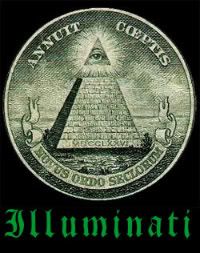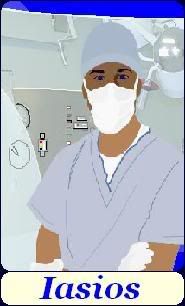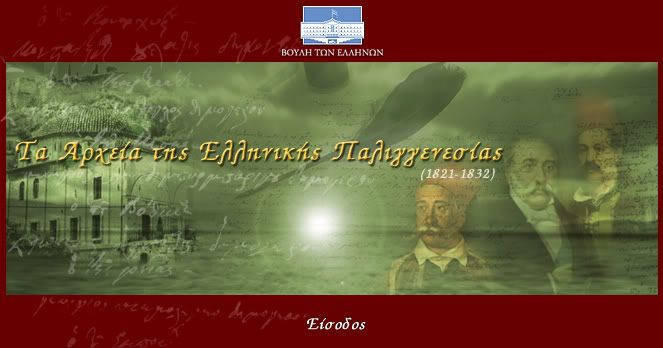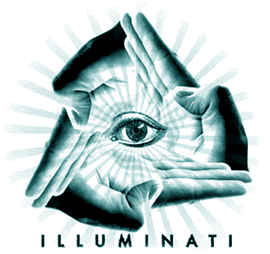 National Treasure
National Treasure
The Book of Secrets
(2007)
While Ben Gates is presenting new information about John Wilkes Booth and the 18 pages missing from Booth's diary, a man by the name of Mitch Wilkinson stands up and presents a missing page of John Wilkes Booth's diary. Thomas Gates, Ben's great-grandfather, is mentioned on the page. It shows that Ben's great-grandfather was a co-conspirator in Abraham Lincoln's murder. When doing more research, the conspiracy takes Ben, Abigail Chase, and Riley Poole to Buckingham Palace (which they break into). They discover a plank that has early Native American writing on it. The plank has only one symbol that Patrick Gates can identify. The symbol is Cibola (see-bowl-uh) meaning the City of Gold. In order to define the rest the have to go to Ben's mother, Patrick's divorced wife. After 32 years it brings back old arguments. After that the other clue is in the President's desk in the Oval Office in the White House (which Ben and Abigail sneak into) to discover that the clue lies in The President's Book. But in order to see the book, their choice is either get elected president or kidnap the President of the United States. Which do they choose? It's obvious. With Wilkinson close on their tail, they find the book in the Library of Congress. The conspiracy then crosses to Mount Rushmore where the clue was on the hills, but (according to the Book) President Calvin Coolidge had the faces carved in so no one can find the City of Gold. When they get there they find out that they must work with Wilkinson since he has some clues of his own. Who will claim Cibola? And will the name of Gates be known as murder?
31/12/08
National Treasure. The Book of Secrets
The Orion Conspiracy

Τι να πιστέψει κανείς. Δεν θα κάνω σχόλια όπως πάντα. Απλά το καταθέτω κι ο καθένας ας βγάλει τα συμπεράσματα του.

From Vimanas discovered by Hitler to countless recovered extraterrestrial crafts, going through the Philadelphia Experiment and HAARP, be debriefed on the Orion Conspiracy and the terrible truth. “The Orion Conspiracy” is a two-year work by French artist Seb Janiak.
or you can watch it in the official site HERE
στο Ierofantis videoblog
Did we really land Men on the Moon?
Did we landed on the moon?
και
Nazis - The Occult Conspiracy !!!
30/12/08
The Deyo Diaries. Volume one - UFOs are Here
 Featuring:
Featuring:
Steven Spielberg, Stan Deyo, Jacques Vallee, Prof. Allen Hynek, Stanton Friedman, Margaret Mead, Ken Arnold, Betty Hill, Rev. William Gill, Klaus Nobel, RAAF Sqdn Ldr White, Ray Palmer and Colin Cameron.
This amazing UFO documentary film was produced in 1977. It was way ahead of its time. Sadly, the master copies of this film and the two which followed it have been lost to the ravages of time. Only one VHS copy of it survived; so Channel 9 gave permission to be converted to digital video in an effort to be preserved as an archive for the use of posterity.
This film inspired Stan Deyo to write "The Cosmic Conspiracy" book which is the sequel to the shows. The man-made, flying saucer programs are exposed in the book and the film
29/12/08
National Treasure
 National Treasure
National Treasure
(2004)
Ben Gates comes from a family of treasure hunters. Now his grandfather believes that the forefathers' buried a treasure somewhere in the country and have placed clues everywhere but unfortunately the clues are highly cryptic and scaterred all over the place. Now Ben thinks he has found it but it only leads him to another clue which is on the back of the Declaration of Independence. Now one of his associates Ian wants to steal it so that they could get the clue but Ben refuses to do it so he tries to kill Ben. But Ben evades him and tries to warn the authorities about Ian's plans but they don't believe him. So Ben takes it upon himself to steal it in order to protect it. And he does but Abigail Chase the curator of the National Archives, where it is kept, discovers what he has done and tries to stop him but gets caught in the crossfire between Ben and Ian, so Ben takes her with him. While she doesdn't believe him, he is determined to prove he is right about the treasure. But it won't be easy cause Ian's always a step behind him and he is being hunted by the FBI.
28/12/08
The Day after Roswell
Secret Space vol I
 SECRET SPACE takes you deep inside the dark occult world of NAZI Germany, where Jews and ex-French Resistance fighters were used as slave labour to develop rocket-based weapons such as the V2 and the V1 'Doodlebug' - the forerunner of today's 'Cruise' missile.
SECRET SPACE takes you deep inside the dark occult world of NAZI Germany, where Jews and ex-French Resistance fighters were used as slave labour to develop rocket-based weapons such as the V2 and the V1 'Doodlebug' - the forerunner of today's 'Cruise' missile.We explain how ex-SS Nazis were brought to America by the CIA under 'Project Paperclip' and given senior posts at NASA.
We also see how NASA's Jet Propulsion Lab in Pasedena was set-up by Jack Parsons - a rocket engineer who was a disciple of Aleister Crowley. From the late 1940s onwards, an unholy alliance of O.T.O devotees, NAZIs and senior 33rd degree Freemasons dupe the American taxpayer of billions of dollars and fake several moon missions in order to further their work on secret 'black budget' operations - a series of secret space programmes designing space vehicles and weapons systems to thwart attacks by alien craft...
For the first time on film we see the 'Baby Shuttle' - a small space shuttle which fits inside the payload of the existing space shuttle and is then released into outer space for covert operations....
It sounds incredible - but SECRET SPACE contains a wealth of documents, photos and footage which proves that all this and more has come to pass. SECRET SPACE exposes the fact that nearly all the first American astronauts into space were high ranking 32 and 33rd degree Freemasons. And that the brother of one of the Apollo Mission managers was appointed Sovereign Grand Commander of all Freemasons in America as a 'thankyou' for engineering the fake Apollo moonshots of 1969.
By using rocket technology invented by arch occultist, Jack Parsons, NASA supremo Werner Von Braun and his team of ex-NAZIs began filming the many UFOs which Astronauts reported during their early spaceflights. They named the NASA space craft after Gods of mythology and even named the 'Titan' rocket after their mentor Aleister Crowley.
We expose NASA's biggest secret - that the existence of alien craft has been known about since the early 1950s and that Nikola Tesla's 'Death Ray' patents are being developed into space-based weapon systems in order to shoot down invading alien craft - just as reported by senior Pentagon officer, Colonel Philip Corso in his book 'The Day After Roswell'.
24/12/08
Secret Space, vol II. Alien Invasion - 4/4. Reptilian Brotherhood of the Snake
 A well put together documentary revealing a wide range of evidence that points towards NASA hiding a big secret to mankind "we are not alone and have never been alone" In the past conspiracy theorists have been branded a bad name because the theory most of the time consisted of no evidence and the story would take on all kinds of twist as the conspiracy would circulate through the public like chines whispers. In the past five years due to the rise of the world wide web a lot of conspiracy theories are now being taken serious. Information has become public because of the web, credible evidence is now to the normal person viable, we are able to validate claims made by looking through archives and company websites. Conspiracy theory is no longer "theory" but a evidential conspiracy with credible people revealing secrets within the system.
A well put together documentary revealing a wide range of evidence that points towards NASA hiding a big secret to mankind "we are not alone and have never been alone" In the past conspiracy theorists have been branded a bad name because the theory most of the time consisted of no evidence and the story would take on all kinds of twist as the conspiracy would circulate through the public like chines whispers. In the past five years due to the rise of the world wide web a lot of conspiracy theories are now being taken serious. Information has become public because of the web, credible evidence is now to the normal person viable, we are able to validate claims made by looking through archives and company websites. Conspiracy theory is no longer "theory" but a evidential conspiracy with credible people revealing secrets within the system.
Alien Invasion
part four
Reptilian Brotherhood of the Snake
22/12/08
Secret Space, vol II. Alien Invasion - 3/4
 A well put together documentary revealing a wide range of evidence that points towards NASA hiding a big secret to mankind "we are not alone and have never been alone" In the past conspiracy theorists have been branded a bad name because the theory most of the time consisted of no evidence and the story would take on all kinds of twist as the conspiracy would circulate through the public like chines whispers. In the past five years due to the rise of the world wide web a lot of conspiracy theories are now being taken serious. Information has become public because of the web, credible evidence is now to the normal person viable, we are able to validate claims made by looking through archives and company websites. Conspiracy theory is no longer "theory" but a evidential conspiracy with credible people revealing secrets within the system.
A well put together documentary revealing a wide range of evidence that points towards NASA hiding a big secret to mankind "we are not alone and have never been alone" In the past conspiracy theorists have been branded a bad name because the theory most of the time consisted of no evidence and the story would take on all kinds of twist as the conspiracy would circulate through the public like chines whispers. In the past five years due to the rise of the world wide web a lot of conspiracy theories are now being taken serious. Information has become public because of the web, credible evidence is now to the normal person viable, we are able to validate claims made by looking through archives and company websites. Conspiracy theory is no longer "theory" but a evidential conspiracy with credible people revealing secrets within the system.
Alien Invasion
part three
20/12/08
Secret Space, vol II. Alien Invasion - 2/4. Alien Moon
 A well put together documentary revealing a wide range of evidence that points towards NASA hiding a big secret to mankind "we are not alone and have never been alone" In the past conspiracy theorists have been branded a bad name because the theory most of the time consisted of no evidence and the story would take on all kinds of twist as the conspiracy would circulate through the public like chines whispers. In the past five years due to the rise of the world wide web a lot of conspiracy theories are now being taken serious. Information has become public because of the web, credible evidence is now to the normal person viable, we are able to validate claims made by looking through archives and company websites. Conspiracy theory is no longer "theory" but a evidential conspiracy with credible people revealing secrets within the system.
A well put together documentary revealing a wide range of evidence that points towards NASA hiding a big secret to mankind "we are not alone and have never been alone" In the past conspiracy theorists have been branded a bad name because the theory most of the time consisted of no evidence and the story would take on all kinds of twist as the conspiracy would circulate through the public like chines whispers. In the past five years due to the rise of the world wide web a lot of conspiracy theories are now being taken serious. Information has become public because of the web, credible evidence is now to the normal person viable, we are able to validate claims made by looking through archives and company websites. Conspiracy theory is no longer "theory" but a evidential conspiracy with credible people revealing secrets within the system.Alien Invasion
part two
Alien Moon
18/12/08
Secret Space, vol II. Alien Invasion - 1/4
 A well put together documentary revealing a wide range of evidence that points towards NASA hiding a big secret to mankind "we are not alone and have never been alone" In the past conspiracy theorists have been branded a bad name because the theory most of the time consisted of no evidence and the story would take on all kinds of twist as the conspiracy would circulate through the public like chines whispers. In the past five years due to the rise of the world wide web a lot of conspiracy theories are now being taken serious. Information has become public because of the web, credible evidence is now to the normal person viable, we are able to validate claims made by looking through archives and company websites. Conspiracy theory is no longer "theory" but a evidential conspiracy with credible people revealing secrets within the system.
A well put together documentary revealing a wide range of evidence that points towards NASA hiding a big secret to mankind "we are not alone and have never been alone" In the past conspiracy theorists have been branded a bad name because the theory most of the time consisted of no evidence and the story would take on all kinds of twist as the conspiracy would circulate through the public like chines whispers. In the past five years due to the rise of the world wide web a lot of conspiracy theories are now being taken serious. Information has become public because of the web, credible evidence is now to the normal person viable, we are able to validate claims made by looking through archives and company websites. Conspiracy theory is no longer "theory" but a evidential conspiracy with credible people revealing secrets within the system.Alien Invasion
part one
Secret Space, vol II. Alien Invasion
Alien Invasion
part one
part two
part three
part four
or
watch
Secret Space vol.II
complete
here

Alien Files
British UFO Files
- here
Secret Space
- vol. I
- vol. II
Ships of Light - The Carlos Diaz UFO Experience
- part 1
- part 2
The Day after Roswell
- here
The Secret KGB UFO Files
- here
UFOs. It has Begun
- here
The Deyo Diaries
- Volyme one: UFOs are Here
UFOs in 90's
- here
The Orion Conspiracy
- here
UFO Files
- Ancient Aliens
- When UFOs Arrive
- UFO Hunters
- Gray's Agenda
- Cattle Mutilations
- Pacific Bermuda Triangle or The Dragon's Triangle
- Crop Circle Controversy
- Hangar 18: The UFO Warehouse
16/12/08
Beyond the Crete
 The mysteries of Zeus-god’s birth in the cave of Crete and the first revolution in the world, that of Zeus-king.
The mysteries of Zeus-god’s birth in the cave of Crete and the first revolution in the world, that of Zeus-king.Visit the source of her downfall – the mighty volcano of Thira. And feel the inevitability of exit beyond existence., and perceive the mystery of eternal return.
From wandering in search of a center of one self. To the center of Self.
14/12/08
1945: The Year That Changed The World
1945: The Year That Changed The World
The Future Takes Shape-October, November and December
12/12/08
Riddles in Stone
"The Symbols Reveal and Conseal"
Secret Mysteries of America's Beginnings
Volume II

Riddles in Stone
The Secret Architecture of Washington, D.C.
10/12/08
The Royal Ripper - & - Lady Die

The truth about "Jack the Ripper" comes to the surface.
A secret for long concealed breaths on open air.
The role of British Royal family in the murders of those women, who protected them and why.
Was it a conspiracy or not?
Are Freemasons behind this conspiracy?
at Skoupidiaris
A new version of the story of "Jack the Ripper"
based on the information found in the diary of inspector of Scotland Yard,
Frederick Abberline

Lady Diana.
A Spencer family member.
Was she intentionally killed?
Is Royal family behind her death?
Watch a small part of the 4 hour video "Lady Die"
9/12/08
The Da Vinci Code
8/12/08
6/12/08
4/12/08
2/12/08
Big Brother, the Big Picture

David Icke speaks to the constituents of Haltemprice and Howden about the 'Big Brother' election, forced by the resignation of David Davis, and the move towards the global Big Brother enslavement we are all facing.
30/11/08
Turning of the Tide
 Exposing the real story behind global events, which shape the future of human existence and the world we leave our children.
Exposing the real story behind global events, which shape the future of human existence and the world we leave our children.
The veil lifts on an astonishing web of interconnected manipulation to reveal that the same few people, secret societies and organizations control the daily direction of our lives, & how the same people on apparently different sides of politics are actually connected to the same elite organizations.
These organizations have the same proven agenda of a world government, a world central bank, a world army, a world currency, and some say a micro-chipped population.
"OPPO-SAMES" These apparent opposites in politics are there to persuade us that we are not living in a prison, that we have a choice. Yet these persons are not opposites at all but are part of a one-party state.
The last two US Presidents were apparently opposites and on different sides - Bill Clinton and George Bush - yet they were both heavily involved within the same elite organizations. David Icke explains: "What happens in practice is that if you look at all the dogmas in all cultures, all societies have what I call a 'hassle-free zone.' It is that area within any culture, within each dogma (religious, economic, political etc) wherein if you conform to it, you are in the comfort zone. No one's going to laugh at you, condemn you for being different, or for expressing your uniqueness, because you are locked into the herd mentality, and you are conforming to what you are told you should be and do.
When you step out of this mind-set and express your unique aspect of all that exists and refuse to be frightened, or controlled, you immediately face ridicule or condemnation as I have in England." "THE SHEEPLE" "Whatever happened to living?
The vast majority of people, rich and poor, on this planet are enslaved. Enslaved by the system's robotic programming, its economic imprisonment, and by their own refusal to think, question and find the liberation that comes with an open mind. We don't live in a free society, we live as robots in a society in which you are free to do what the society wants you to do - produce and consume - that's the reality."
Who Controls The World?
Who Controls The World?

Internet Censorship
24/11/08
Bush family and Nazi regime connection
10/11/08
9/11 The Falling Man
But there was one story that people didn't want to face.
The story of the people who began to jump from the World Trade Center just minutes after the first plane hit. Their images were caught on videotape and in photographs, but soon they were never seen again, as if they had never existed.
Among those pictures is one of the most unforgettable images from 9/11 - a photograph of a falling man, frozen in mid air, his body perfectly parallel with the twin towers of the World Trade Center
9/11 The Falling Man
PRESS FOR TRUTH
This documentary presents the many-faceted events that led up to, and then scrutinizes, the 9/11 Comission hearings. Massive injustices and mis-representations are brought to light and "exposed" by respected members of the mainstream American media, and from the families themselves in the narrative of events that shaped most greatly our world today.
"9/11: Press for Truth" The families present their 2 1/2 year struggle to create an investigation and inquiry into the events of 9/11 -- which was at first heavily resisted and even explicity prohibited by the President and Vice-President. For an example of contrast in funding; the internal disruption of a Clinton-Lewisnki "sex scandal" the event was awarded a budget of 100 million dollars in total. Initially the 9/11 Comission was only alotted 3 million dollars and their time-limit was severly cut beyond the expecations of those who brought it into existence.
PRESS FOR TRUTH
9/11/08
911: In Plane Site
Brilliantly done with an excellent soundtrack which keeps the video moving along a quick yet well paced and documented pace.
In Plane Site
8/11/08
Loose Change (2nd Edition)
Loose Change
2nd Edition (updated)
7/11/08
6/11/08
The Man Who Saw Tomorrow
Did 16th century French astrologer and physician Nostradamus actually predict such events as the fall of King Louis XVI, the rise of Napoleon and Hitler, the assassination of JFK, and even an arab "antichrist" wearing a blue turban who would attack NY from the air? And are there other prophecies that have yet to come true?
Hosted by Orson Welles.
The Man Who Saw Tomorrow
4/11/08
The 2012 Enigma
The 2012 Enigma
by David Wilcock
2012: Tragedy, transcension or just another year?
David Wilcock exposes many great secrets:
DNA, consciousness science, wormholes, stargate travel, sacred geometry, three-dimensional time, the Mayan Calendar and much, much more!
Part I:
CONVERGENCE The Movie, consciousness energy field, Edgar Cayce reincarnation, Da Vinci Code, Inconvenient Truth, galactic alignment, dodecahedron, 2012 / DNA crop circles, sacred geometry as vibration, tetrahedron, 19.5 degrees
Part II: Hans Jenny / Cymatics, space and time inverting, wave-particle duality, Buckyballs / fullerenes, DNA as a wave, Kaznacheyev, psychic healing, Dewey Larson, 3D time, space-time fabric, time-space
Part III: Fairy circles, natural stargates, ESP, nested spheres, channeling, chakras, Pineal gland, Sumerian tablets, Osiris, kundalini, pine cone symbolism, Tammuz, Shiva, Third Eye, Bindi, Bacchus, Dionysus, Jesus, the Vatican
Part IV: Pyramid sarcophagus, cathedral windows, the World Tree, melatonin, DMT, ayahuasca, Dreams, Out of Body Experience, the Silver Cord
Part V: Mark of the Beast, microclusters, synchronicity, shamanism, holographic sound, reverse-engineering the pineal gland, Dan Burisch, Project Looking Glass, CONTACT
Part VI: The Last Mimzy, the Roswell Crash, the Cube / Yellow Disc, Hellraiser, election tampering, pole shift, time-viewing technology, the Iraq War, DCTP / Doctrine of the Convergent Timeline Paradox, human-lineage ETs
Part VII: Tree of Life, Illuminati, Rothschilds, Hitler, New World Order, Lucifer, Luciferian philosophy, Catholic church, Philadelphia Experiment / Rainbow Project
Part VIII: Phoenix III, Montauk chair, time travel, Dec. 21, 2012, 20-year cycle, Stargate SG-1, Outer Band Individuated Teletracer / OBIT, The Outer Limits, Time Vector Generator / TVG, Mars pyramids, underground bases, jumproom, Total Recall, Minority Report, X-Men / Cerebro, Rifts in Time
Part IX: Forbidden Planet, psychic conduit, LSD trips, zero-time, 2012 dimensional shift, Edgar Cayce readings, Chandler’s Wobble, pole shift, Library of Atlantis / Hall of Records, California earthquakes
Part X: Create your own reality, 2012 not cataclysmic, Russian physics, Dr. Sergey Smelyakov / Auric Time Scale, Mayan Calendar, spiral imploding into 2012 changing consciousness, Ascended abilities, spiritual growth
30/10/08
Illuminati and New World Order
29/10/08
The 9/11 Chronicles: Truth is Rising. All 11 parts
Ο Alex Jones είναι ο δημιουργός αυτών των video και έχουν δημοσιευτεί στο τηλεοϊστότοπο του στο YouTube.
Truth is Rising
21/9/08
Ερώτηση: Τι εθνικότητος ήταν ο Μέγας Αλέξανδρος;
Δείτε την απάντηση.......................;;;;;;;;;;;;;;;;;;;;;;;;;;;;;;;;;;;;;;;;;;;;;;;;;;;;;;;;;;;
αν δεν το καταλάβατε ακόμα, ο Μέγας στρατηλάτης μιλούσε ..... Σλαβικά
"Άθελά του κι εδώ ο Πούτιν ξαναπαίζει τον ρόλο του. Εδώ εκπροσωπείται από το πλήρωμα ενός υποβρυχίου που αναδύεται ... στην Makedonija!Α, ναι η διαφήμιση γυρίστηκε για λογαριασμό της Cosmofon, θυγατρική της Cosmote στην πΓΔΜ..."
(από τα σχόλια του ανώνυμου φίλου για το ρόλο του Πούτιν)
(αυτή η ανάρτηση έχει ως αφορμή τα σχόλια ενός ανώνυμου σχολιαστή σε παλιότερη ανάρτηση μου για τον Μέγα Αλέξανδρο)
Τι στο διάολο, τυφλοί είναι οι κυβερνώντες μας; Δεν βλέπουν τι γίνεται;
Κι εμείς τι κάνουμε; Το καταπίνουμε έτσι εύκολα;
5/8/08
Πεντάγωνο - ΗΠΑ - 11/9/2001
Με αφορμή την ανάρτηση του φίλου Δικαιόπολις :
"ΤΙ ΕΓΙΝΕ ΣΤΟ ΠΕΝΤΑΓΩΝΟ ΤΗΝ 11 ΣΕΠΤΕΜΒΡΙΟΥ ???"
Βλέπετε τον πύραυλο;;;;;;;;;;;;
Ξανά!! Πουθενά Boeing 757. Μόνο ένας πύραυλος..
Που; Που.... είναι το αεροπλάνο;
Τα συμπεράσματα δικά σας.
Links:
- 9/11 Research
- 9/11 CitizensWatch
- 9/11 Truth
2/7/08
12784 Μέρες Κατοχής
Το ΑΛΛΟΥ ΚΙ ΑΛΛΟΥ...
διοργανώνει εβδομάδα διαδικτυακών προβολών
για την τουρκική εισβολή στην Κύπρο
από τις 17 έως και τις 23 Ιουλίου 2008.
Όσοι bloggers επιθυμούν να συμμετάσχουν
μπορούν να στείλουν email
με ένα κλικ ΕΔΩ !
1/6/08
26/5/08
Vatican Assassins
Eric Jon Phelps
the writer of
Vatican Assassins - Wounded in the house of my friends
in Freemans Perspective
at

14/5/08
Έχει νόημα να είσαι Έλληνας
Έχει νόημα να είσαι Έλληνας; Έχουμε βρει, ως Έλληνες, την ταυτότητά μας; Τι τελικά είναι πολιτισμός ...και χρειαζόμαστε την ελληνική γλώσσα;
Απαντήσεις σε αυτά κι άλλα τόσα ερωτήματα έδωσε ο καθηγητής Φιλοσοφίας και Πολιτιστικής Διπλωματίας στο Πάντειο Πανεπιστήμιο Πολιτικών και Κοινωνικών Επιστημών της Αθήνας,
κ. Χρήστος Γιανναράς. Κάποιοι ίσως τον γνωρίζουν από την τακτική επιφυλλιδογραφία του στο Βήμα και στην Καθημερινή. Εμείς τον ακούσαμε στο Συνέδριο του Συμβουλίου Απόδημου Ελληνισμού Περιφέρειας Ευρώπης στη Φραγκφούρτη, στις 10 Νοεμβρίου 2002.
Όσοι παρακολούθησαν την εισήγησή του έμειναν κατενθουσιασμένοι και συγκινημένοι.
Σκεφτήκαμε λοιπόν να σας μεταφέρουμε αποσπάσματα της εισήγησης του κυρίου καθηγητά...
(Ευχαριστούμε θερμά την κυρία Διαμαντένια Ριμπά – δημοσιογράφο του ΜΠΕ – για την πολύτιμη βοήθειά της).
ΕΛΛΑΔΑ
«Οι Έλληνες πάντοτε είχαμε αυτό το προσόν: ήμασταν ένα σταυροδρόμι. Μας λένε ‚που
είσαστε; Ανατολή είσαστε, Δύση είσαστε;’ Όχι! Ήμασταν πάντα ένα σταυροδρόμι. Παίρναμε από παντού. Σκεφτείτε, τι ήταν η Αρχαία Αλεξάνδρεια: Σταυροδρόμι Πολιτισμών, Ηπείρων, Ιδεών, Τεχνών. Αλλά τότε είχαμε την ικανότητα και προσλαμβάναμε και αφομοιώναμε.
Το πρόβλημα αρχίζει από τη στιγμή που αρχίσαμε να προσλαμβάνουμε και να υποτασσόμαστε σε αυτό που προσλάβαμε...»
ΕΛΛΗΝΑΣ
«Απαιτείται ένα πάρα πολύ υψηλό επίπεδο καλλιέργειας για να συνειδητοποιήσεις τι σημαίνει να είσαι Έλληνας.
Θα μου πείτε: η αγράμματη γριά που έφτιαχνε εκείνα τα απαράμιλλα κεντήματα στην τουρκοκρατία, που σήμερα τα βάζουμε στο Μουσείο, δεν είχε τέτοιες συνειδητοποιήσεις. Ναι, αλλά αυτός ο τύπος ανθρώπου, φοβάμαι ότι τελικά έχει χαθεί. Μην ξεχνάτε ότι ζούμε στην εποχή‚ μετά την τηλεόραση’...
Σήμερα για να είσαι Έλληνας πρέπει να παλέψεις ...για να είσαι Έλληνας.
Πρέπει να δουλέψεις για να συνειδητοποιήσεις τι θα πει να είσαι Έλληνας. Και τελικά αυτό που θα σε κάνει Έλληνα δεν είναι μόνο η γνώση του τι θα μάθεις για την ελληνική παράδοση. Είναι η χαρά μιας εύρεσης. Είναι αντίστοιχη χαρά ενός έρωτα. Όταν ανακαλύψεις τι δυνατότητες έχει η παράδοσή σου, τότε πράγματι είσαι ένας ερωτευμένος... και τότε είσαι Έλληνας!»
ΠΑΙΔΕΙΑ ΚΑΙ ΓΛΩΣΣΑ
“Τα γονίδια δεν συνιστούν την οργανική συνέχεια. Την οργανική συνέχεια την συνιστά η
Παιδεία.
Αυτό που λέει ο Ελύτης πάρα πολύ ωραία, ότι ακόμα και ο τελευταίος ψαράς κι ο τελευταίος χωρικός στην Ελλάδα λέει τη ‚θάλασσα’ θάλασσα και τον ‚ουρανό’ ουρανό, όπως ο Όμηρος. Αλλά να έχει επίγνωση ότι συνεχίζει αυτή την παράδοση...
Η συνέχεια της ελληνικής γλώσσας είναι πολύ μεγάλη υπόθεση, ιερή υπόθεση.
Χάρηκα τόσο πολύ που ήσασταν αυτή τη φορά επιθετικοί απέναντι στην κρατική πολιτική στα
θέματα παιδείας.
Επιτέλους πια ο Έλληνας να απαιτήσει από αυτούς που διαχειρίζονται τις τύχες του: Παιδεία για τα παιδιά του.
Δεν είναι δυνατόν ο οποιοσδήποτε άσχετος να παίζει πάνω στις ψυχές των παιδιών μας
δεκαετίες τώρα.
Μεταρρυθμίσεις και κόντρα μεταρρυθμίσεις και κομματισμοί και οι ημέτεροι στο εξωτερικό και οι μη ημέτεροι να αποκλείονται. Και καμία αξιοκρατία και κανένας έλεγχος και κυριολεκτικά μία κατάσταση με διαλυμένα Πανεπιστήμια. Και να μιλάμε μετά για ελληνική παιδεία. Στο χέρι μας
είναι να τους πιέσουμε πια επιτέλους. Δεν ζητάμε τίποτα περισσότερο.
Ζητάμε να μπορούν τα παιδιά μας να μαθαίνουν γράμματα, σωστά, και να φυλάξουν αυτή τη γλώσσα, την οποία έχουν βαλθεί να την εξασθενίσουν οι πάντες στην Ελλάδα.
Από την κατάργηση της διδασκαλίας των Αρχαίων που σήμερα έχει φτάσει στο σημείο Έλληνες κάτω των 30 ετών να μην καταλαβαίνουν καν τον Παπαδιαμάντη και το Ροΐδη μέχρι την τραγική καταστροφή, που ήταν το μονοτονικό και που ψηφίστηκε από τη Βουλή των Ελλήνων με έκθεση εισηγητική της εταιρίας Olivetti.
Θέλω να ξέρετε το μονοτονικό στην Ελλάδα το εισήγαγαν οι πολυεθνικές των κομπιούτερς και των τυπογραφικών μηχανών.»
ΠΟΛΙΤΙΣΜΟΣ
«Πολιτισμός είναι ο τρόπος του βίου.
Ο τρόπος που χτίζουμε τα σπίτια μας, που διακοσμούμε τα σπίτια μας, που ντυνόμαστε, που
μιλάμε, που γράφουμε ποιήματα, που ερωτευόμαστε.
Αυτό είναι Πολιτισμός!
Θα μου πείτε γιατί διαφοροποιούνται οι Πολιτισμοί. Διότι πίσω από αυτόν τον τρόπο του βίου φαίνεται μία ιεράρχηση αναγκών: τι είναι για εμάς πρώτο, τι είναι δεύτερο. Οι αρχαίοι Αθηναίοι που χτίζανε αυτά που χτίσανε επάνω στην Ακρόπολη, ξέρουμε ότι μένανε σε πενιχρές κατοικίες. Πολύ πενιχρές. Γι΄ αυτούς το πρώτο δεν ήταν να έχουν ανάκτορα ή επαύλεις. Ήταν να φτιάξουν αυτά που έφτιαξαν. Ήταν να είναι Πολίτες!
Βέβαια, πίσω από την ιεράρχηση των αναγκών υπάρχει πάντα ένα νόημα. Τι νόημα έχει η ύπαρξη, τι νόημα έχει να υπάρχω, τι νόημα έχει αυτή η ζωή, από που ήρθα, που πηγαίνω... τι κάνω. Τι νόημα έχει το κάλος, τι νόημα έχει ο έρωτας.
Εάν δεν δίνω νόημα σε όλα αυτά ...τότε είμαι ένα απλώς εξελιγμένο θηλαστικό.
Έχει κάποιο νόημα να είσαι Έλληνας.
Δεν είναι απλώς ιδεολογικό γεγονός, ψυχολογικό γεγονός. Έχει νόημα να είσαι Έλληνας, όταν είναι πλούτος ζωής. Όταν έτσι χαίρεσαι πληρέστερα τη ζωή σου…
Η ιστορία κρίνεται στη δυναμικότητα ενός πολιτισμού που επιβιώνει 3.500 χρόνια. Επιβιώνει ως γλώσσα, ως νοοτροπία, ως τέχνη, δηλαδή ως φανέρωση ενός νοήματος ζωής που πράγματι ενδιαφέρει πανανθρώπινα.
Σκεφτείτε τι θα λέγαμε αν κάποιος μας πληροφορούσε ότι οπουδήποτε της γης Έλληνες κάθε εβδομάδα ανεβάζουν μία Αρχαία τραγωδία. Θα λέγαμε ότι αυτό είναι πράγματι συνέχεια πολιτισμού.
Επιτρέψτε μου να πω ότι αυτό συμβαίνει.
Όπου της γης Έλληνες, σε οποιαδήποτε γωνιά της γης κάθε εβδομάδα τελείται η Ορθόδοξη Λειτουργία, η οποία είναι οργανική συνέχεια της Αρχαίας Ελληνικής Τραγωδίας. Με τους δυο χορούς, τους κορυφαίους, τις εισόδους, εξόδους, τα αντίφωνα. Με μία ποίηση ιλιγγιώδη, με μια ζωγραφική μοναδική, με μια μουσική ανυπέρβλητη. Ένας πολιτισμός που μπορεί να είναι σε παρακμή σήμερα, αλλά εξακολουθεί να συνεχίζεται σαν λαϊκή πράξη.
Μπαίνετε σε μια προτεστάντικη εκκλησιά και ακούτε τις παιδαριωδίες:
«Να ‘σαι καλό παιδάκι, να μην κλέβεις, να μη σκοτώνεις, να μη λες ψέματα, ...να πούμε κι ένα τραγουδάκι».
Και μπαίνετε σε μία Ορθόδοξη Εκκλησιά κι ο άλλος ψέλνει, τραγουδάει...»
ΠΕΡΝΑΜΕ ΚΡΙΣΗ...
«Περνάμε μία κρίση παρακμής. Μία κρίση νοσηρότητας. Οι Έλληνες έχουμε φτάσει σε σημείο να ντρεπόμαστε που είμαστε Έλληνες. Πολλοί από τους Έλληνες διανοούμενους θα ήταν πανευτυχείς εάν ήταν τίποτα Βέλγοι, τίποτα Ολλανδοί, κάτι άλλο. Όχι Έλληνες. Είναι ντροπή. Κι αυτό το βγάζουν στα γραπτά τους, στην πολιτική τους, σε αυτά που εφαρμόζουν. Γιατί αυτό το μένος, στα σχολικά βιβλία να έχει αφαιρεθεί κάθε αναφορά, στα αναγνωστικά των τριών πρώτων τάξεων του Δημοτικού, στο΄21; Κάθε αναφορά...
Διαβάστε τι γράφει στο βιβλίο Ιστορίας του Γυμνασίου ...ή του Λυκείου για το Βυζάντιο. Αυτά τα οποία έλεγαν κάποιοι το 1920 ότι ήταν κληρικοκρατία και σκοταδισμός και μεσαίωνας. Στο μεταξύ η έρευνα έχει ανατρέψει τα πάντα από αυτά! Τίποτα, εμείς στα σχολικά μας βιβλία κατασυκοφαντούμε την ιστορία μας. Διότι έτσι νομίζουμε ότι είμαστε προοδευτικοί.
Είναι μία αρρώστια... θα περάσει... Μία ιλαρά είναι. Κρατά ίσως κάποιες δεκαετίες, κάποιους αιώνες, μα ...θα περάσει...
Η τελευταία, η μόνη ελπίδα, είναι να βρει ο Οικουμενικός Ελληνισμός τη δυναμική του, την
αίσθηση της αρχοντιάς του!
Ο Μακρυγιάννης έλεγε ότι από εμάς τους Έλληνες‚ όλα τα θερία τρώγουν, αλλά στο τέλος
μένει πάντα κάποια μαγιά’. Το ερώτημα είναι, να μείνει κάποια μαγιά. Μπορεί να μείνει ένα 0,2% πραγματικών Ελλήνων; Τότε θα συνεχιστεί η πρόταση πολιτισμού. Έστω κι αν όλοι αλλοτριωθούν, έστω κι αν όλοι υποκύψουν.
Μια μαγιά να σωθεί. Υπάρχει ελπίδα!...»
Σοφία Καρυπίδου
ΠΗΓΕΣ:
4/5/08
Battle of Thermopylae 480 BC
The unforgettable battle between the vast army of Persian King Xerxes and the Heroic King of Sparta Leonidas with his 300 Spartan warriors
Leonidas and his Spartans died in defense of the highest human value
The future of World would definitely be different if Xerxes and his barbaric hordes would succeed to their invasion. Civilisation and freedom would be buried under the ashes
ὦ ξεῖν’, ἀγγέλλειν Λακεδαιμονίοις ὅτι τῇδε κείμεθα τοῖς κείνων ῥήμασι πειθόμενοι
go tell the Spartans, stranger passing by, that here obedient to their laws, we lie
Watch it at

Battle of Cynoscephalae 197 BC
for control of Hellas
Adrianople: Last Great Battle of Antiquity
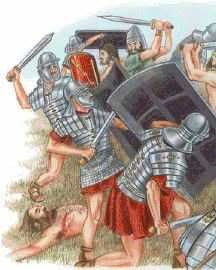 The annals of the later Roman empire are scarred by events that took place near the Thracian city of Adrianople on the afternoon of August 9, ad 378. By that evening, the eastern Roman Emperor Valens was dead along with tens of thousands of irreplaceable warriors, in a defeat that signaled the beginning of the end of Rome’s ability to resist external pressure and prevent penetration of its defenses. According to the contemporary historian Ammianus Marcellinus, himself a Roman officer, “No battle in our history except Cannae [Hannibal Barca’s great victory in 216 bc] involved such a massacre.”
The annals of the later Roman empire are scarred by events that took place near the Thracian city of Adrianople on the afternoon of August 9, ad 378. By that evening, the eastern Roman Emperor Valens was dead along with tens of thousands of irreplaceable warriors, in a defeat that signaled the beginning of the end of Rome’s ability to resist external pressure and prevent penetration of its defenses. According to the contemporary historian Ammianus Marcellinus, himself a Roman officer, “No battle in our history except Cannae [Hannibal Barca’s great victory in 216 bc] involved such a massacre.” After the death of Emperor Constantine in ad 337, the Roman empire saw the return of sibling struggles for total control. Constantine had hoped that his three surviving sons would be satisfied with one-third of the empire each—Flavius Julius Constans in western Europe, Constantine II in southeastern Europe and Constantius II the eastern provinces—but such was not to be. Constantine II was killed in Italy in 340; Constans was overthrown by the usurper Magentius and slain by Gaiso while fleeing to Iberia in January 350. Then Constantius, while moving to deal with a revolt by his cousin, General Flavius Claudius Julianus, died of a fever in Cilicia on November 3, 361. With the death of all three of Constantine I’s direct heirs, Rome was ruled by a succession of army generals.
The general who finally secured the imperial purple on February 26, 364, was Flavius Valentinianus, a man of humble birth but considerable military skill. As Emperor Valentinian I, he focused on shoring up the frontier along the Danube River. To keep the eastern part of the empire in friendly hands, on March 28 Valentinian appointed his brother, Flavius Julius Valens, to the position of co-emperor and placed him in Constantinople. Valentinian died in 375 and was succeeded by his 16-year-old son, Flavius Gratianus, or Gratian. Contemporaries described Gratian as “a young man of remarkable talent: eloquent, controlled, warlike, yet merciful.” During his short life, he fought successfully against Rome’s enemies and vigorously attacked the last vestiges of paganism. At the time he became emperor in the west, however, Gratian was much too inexperienced to hold any sway over his uncle, Valens.
In contrast to his brother, Valens did not join the Roman army until 360. Nevertheless, he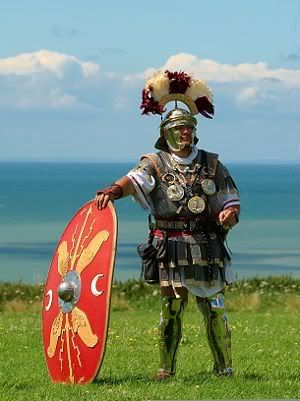 conducted an offensive campaign against the Goths, from 367 to 369, with vigor and skill. In spite of difficulties in carrying out operations against elusive enemies in their home territory, he was able to bring his Goth foes to battle and defeat them.
conducted an offensive campaign against the Goths, from 367 to 369, with vigor and skill. In spite of difficulties in carrying out operations against elusive enemies in their home territory, he was able to bring his Goth foes to battle and defeat them.
According to their own traditions, the Goths originated in a land called Gothiscandza, identified as southern Scandinavia. Those same traditions cite population pressure as the reason for their move to what would become their long-standing homeland between the Oder and Vistula rivers, in what is now Poland. However, no archaeological evidence exists to support this idea. What seems to have happened was a slow, steady drift from the Oder-Vistula region into Scythia, now known as Ukraine. That region already contained a mixed population, and the Goths would certainly have mixed with other peoples to produce a populace that was far from homogeneous. By the middle of the 3rd century, they had become a formidable power.
The leader of a Visigoth tribe called the Tervingians, Fritigern (derived from the Goth word frithugairns, “desiring peace”) was a prominent warrior-king whose followers included a number of Roman subjects as well as Goths. The former ranged from escaped slaves and gold miners to Goth soldiers in the Roman army who, although initially loyal to Rome, had been driven to rebellion by the hostility of the local populace. Fritigern must have been a man of enormous charisma and strength of will. He managed to hold together a confederacy of disparate clans and tribes with no greater authority than their belief in his ability to win. Since Fritigern’s followers included Huns, Roman expatriates and Germanic tribesmen, many would have deserted him had they felt better off under someone else’s leadership.
Compared to the vast trove of information available on the Roman army of the 4th century, virtually nothing is known of the Goth fighting organization—if there was one. Nevertheless, the Goths were not mere wild men, as popularly portrayed in Roman and later accounts. Many had served in Roman armies and knew how to wield a sword, spear or battle-ax with skill. Such weapons were more of a threat to the Romans than in previous centuries due to changes in the Roman infantry. Because of reductions in available funds for military spending, the Roman soldier wore less metal armor, his shield was smaller and rounder and, to compensate, his short stabbing gladius had been replaced by a sword longer than the one he had used in the 1st century. Roman infantry formations were still formidable but had lost some of the invincible aura they had enjoyed in the imperial heyday.
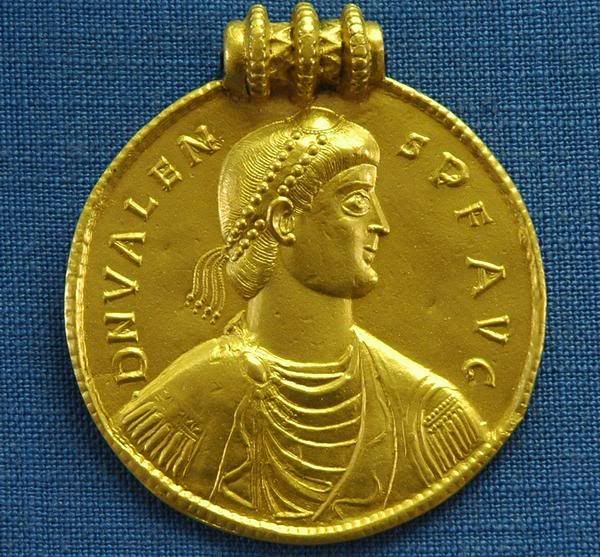 The Goths often fought from a laager, a group of wagons arranged in a circle, from which they would dart out to do battle, then quickly return. This amounted to a mobile fortress that could protect them no matter where they fought.
The Goths often fought from a laager, a group of wagons arranged in a circle, from which they would dart out to do battle, then quickly return. This amounted to a mobile fortress that could protect them no matter where they fought.
In the fall of 376, the Romans agreed to help Fritigern’s people cross the Danube and settle in the province of Moesia. In 377, however, a famine struck the Roman areas settled by the Visigoths, and their appeals for help went unanswered by the Roman authorities. The magister militum (governor-general) of the area, Lupicinus, and his dux secundae, Magnus Maximus, treated the Visigoths badly, forcing them to pay exorbitant prices for food and keeping Goth women as concubines.
As the Goths became restive, Lupicinus invited Fritigern, Alaviv and other Visigoth chieftains to a banquet at his headquarters in Marcianople, planning to make them hostages to keep their tribes in line. His plan failed—a fight broke out and the Romans killed Gothic escorts and Alaviv, but Fritigern managed to fight his way out of the trap.
The Tervingians under Fritigern now rose in open revolt, pillaging the countryside surrounding Marcianople. Lupicinus led a small force to confront them nine miles outside the city, only to be overpowered and massacred.
The crisis continued into 378, with the Visigoths holding sway over much of Thrace, an ancient country in the southeastern part of the Balkan Peninsula, reaching north to the Danube and comprising modern Bulgaria and parts of Greece and Turkey.
Emperor Valens and his army were in Thrace, marching west from Adrianople along the Martisa River valley, when news reached him that the Goths were moving south along the Tundzha River. At first he thought it was only a small raiding party, but he soon realized it was a much larger force. He therefore turned back toward Adrianople and established a fortified camp just outside the city.
Located at the western end of the Thracian plain near the Greek border, 130 miles northwest of Constantinople, Adrianople (now Edirne in Turkey) was originally named Hadrianopolis, for the Roman Emperor Hadrian, who built it in ad 125 on the site of the ancient city of Uskudarna. Lying at the confluence of the Martisa, Tundzha and Arda rivers, it had been of geographic and military importance since ancient times.
Holding a conference with his lieutenants during the night of August 8, 378, Valens faced a crucial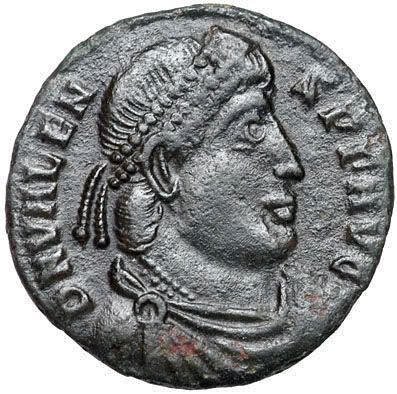 decision: Should he engage the Goths at once or wait for his young nephew and co-emperor, Gratian, to join him? This question resulted in a rift among his senior officers. The more cautious among them recommended that Valens wait and allow Gratian to arrive with his army. The Romans could then move as a combined force to fight a stronger battle and wipe out the entire Goth threat. Gratian’s western contingent was not many days’ march away, they argued, and communications between the two armies had already been established.
decision: Should he engage the Goths at once or wait for his young nephew and co-emperor, Gratian, to join him? This question resulted in a rift among his senior officers. The more cautious among them recommended that Valens wait and allow Gratian to arrive with his army. The Romans could then move as a combined force to fight a stronger battle and wipe out the entire Goth threat. Gratian’s western contingent was not many days’ march away, they argued, and communications between the two armies had already been established.
Another group of officers, led by a general who knew what he was doing, urged immediate action. Comes (Count) Sebastianus had been appointed to overall command in the region two months earlier, and in the previous weeks had adopted an aggressive guerrilla-style mode of campaigning. It had proved immensely successful thus far, forcing the Goths to cease raiding in small bands and coalesce into much larger groups for their own protection. That made them vulnerable to a conventional, large-scale Roman attack. Sebastianus had, in fact, caught and destroyed a large column of Goths returning from a plundering expedition to Rhodope in southern Thrace, shortly before joining Valens and being appointed to command his infantry.
Several factors influenced Valens’ final decision. First, his scouts reported that the Goth force contained only about 10,000 fighting men. Since Valens had about 15,000 soldiers in his own army, it was tempting to engage the Goths in battle then and there. Moreover, Valens’ standing in Constantinople was very low at that time. If he allowed a Goth army to take position between Adrianople and Constantinople, he would not only find his supply lines cut off but also risk the likelihood that the populace in the eastern capital would feel abandoned by their emperor.
Valens’ contemporary, Ammianus, and many later historians believed that the emperor—jealous of his young nephew—decided on an immediate battle to gain personal glory. Though that was perhaps true, it would not have been the only reason for Valens’ hasty actions. He might have underestimated the Goths’ strength, for he had defeated them on the Danube nine years earlier. In any case, Valens seemed confident of an easy victory on the morning of August 9 as he led the field army of the east from Adrianople to attack the Goths, who were camped 12 miles from the city.
The Romans marched rapidly under a blazing sun, coming upon the Goth camp at about 2 that afternoon. The Goths were encamped in a secure position, probably on high and easily defensible ground. The imperial troops were hastily drawn up into battle formation while the Goths broke into savage howls, as they were accustomed to do just before an engagement.
Either because of unfamiliarity with the terrain or by mistake, the right wing of the Roman cavalry came within sight of the Goths while the left was still a considerable distance away, with many of the horsemen on the left wing scattered along roads leading up to the Goth camp. Some historians assume that the Goths fought from behind their wagon laager at Adrianople, but that would have been unlikely. Their usual procedure was to engage their enemies in the open and fall back on the camp only when an encounter was not going well. Had they remained behind the laager, they would not only have surrendered the initiative to the Romans but also would have been unable to use their preferred fighting tactic of charging into hand-to-hand combat with spears, swords and shields. On several occasions Ammianus’ descriptions of the battle explain that one part of the Roman line managed to fight its way forward as far as the wagons, clearly indicating that the fighting took place primarily in the open, beyond the wagon laager.
Riding boldly into the Roman right wing, the Goth cavalry scattered the surprised Roman cavalry line and then turned to attack the Roman left wing. Within moments, all the Roman horsemen had been driven from the field, leaving the weary infantry exposed.
Fritigern chose that moment to burst from the laager at the head of his own infantry. Ammianus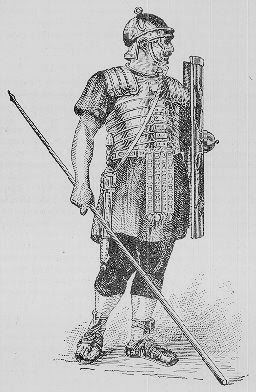 described the Roman soldiers’ plight: “The different companies became so huddled together that hardly anyone could pull out his sword, or draw back his arm, and because of immense clouds of dust, the heavens could no longer be seen….Hence Goth arrows whirling death from every side found their mark with fatal effect, since they could not be seen beforehand nor guarded against.”
described the Roman soldiers’ plight: “The different companies became so huddled together that hardly anyone could pull out his sword, or draw back his arm, and because of immense clouds of dust, the heavens could no longer be seen….Hence Goth arrows whirling death from every side found their mark with fatal effect, since they could not be seen beforehand nor guarded against.”
Hemmed in from all sides, the Roman foot was packed together too tightly to create any effective battle formation. The slaughter was frightful as Fritigern’s infantry closed in, while his cavalry kept any Romans who broke out from getting very far. The battlefield ran red with blood, most of it Roman. Men slipped on the bloody ground, and many died after falling on their own weapons. Heaps of bodies littered the field, including that of Comes Sebastianus.
There are two stories concerning Valens’ fate. One claims that an arrow struck him while he was among the ranks of his army, and his body was never found. The other claims that, wounded by an arrow, he was taken by his guards to a nearby peasant dwelling, which the Goths subsequently attacked. The Roman defenders initially managed to drive back the Goths with arrows, but they soon returned, piled up brushwood and straw against the house and set fire to it. One Roman soldier jumped from a window and was captured by the Goths, but the others, including the emperor, perished in the blaze. The prisoner later escaped to tell the story.
Ammianus stated that two-thirds of the Roman army died at Adrianople. His comparison of the massacre to Hannibal Barca’s tactical masterpiece at Cannae is apt because in both battles Roman horsemen were driven from the field, leaving the infantry to be encircled, hemmed in and destroyed.
The outcome at Adrianople shocked the Western world. The Romans had lost battles before, but never so decisively. Nor had barbarians made Roman commanders look so utterly incompetent at the art of war. From beginning to end, Valens and his generals had been outguessed, outsmarted and outmaneuvered by Fritigern’s Goths.
Various explanations have been offered for this improbable victory by an ad hoc force of refugees and deserters over the best-organized, best-equipped and best-disciplined army in the world. Some observers claimed that, contrary to Valens’ faulty appraisal, the Goths enjoyed a numerical superiority of as many as 200,000 warriors. In fact, given the logistical difficulties of feeding and sustaining so many men, Fritigern would have been lucky to muster one-tenth that number. Other historians claimed that the battle proved the superiority of cavalry over infantry. The truth is that while a timely cavalry charge sealed the battle’s ultimate outcome, it was primarily a clash of infantry with infantry.
The Roman defeat at Adrianople can be attributed to both strategic and tactical reasons. At the strategic level, the Romans were unable to assemble enough high-quality troops to deal rapidly and decisively with the Goth threat. Although the empire had some 500,000 men under arms at that time, they were committed to guarding imperial borders from Britannia to Syria. There was a real danger that if a significant number was moved from one point to another, a potential enemy would take advantage of the weakened border segment to attack. Moreover, while Roman field armies were supposedly mobile and rapidly deployable, orders to move to a new area of operations often resulted in mass desertions that critically thinned their ranks.
When it came to using the force at their disposal, the Roman commanders at Adrianople acted with an arrogance typical of leaders of a well-equipped “civilized” army faced with what they perceived as rabble. Those commanders allowed themselves to be drawn into battle without proper reconnaissance and without ensuring that the odds were stacked in their favor before committing their forces to a fight.
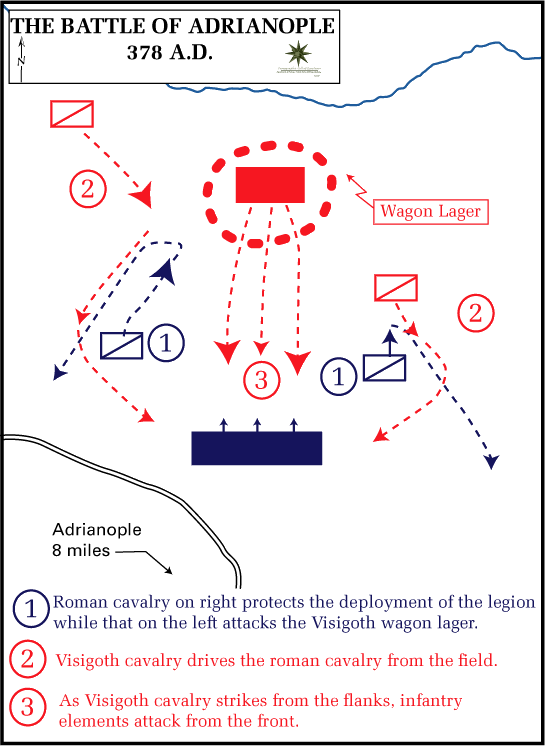 It is also probable that the quality and morale of eastern Roman soldiers were low before the campaign began. Only 13 years earlier, Valens had led them on a rigorous but reasonably successful campaign against the Sassanian Persians, only to abandon the effort and leave Armenia in Persian hands. In any case, it was an overwhelmingly hot August day when Valens’ soldiers marched hurriedly from Adrianople to the plain near where the Goths had been reported. Consequently, they were exhausted and thirsty before the fighting began. It would be unjust, however, to cite the Roman failings without crediting the strategic skill shown by Fritigern; in spite of his logistic problems, the Goth commander managed to dictate the terms and tempo throughout the campaign.
It is also probable that the quality and morale of eastern Roman soldiers were low before the campaign began. Only 13 years earlier, Valens had led them on a rigorous but reasonably successful campaign against the Sassanian Persians, only to abandon the effort and leave Armenia in Persian hands. In any case, it was an overwhelmingly hot August day when Valens’ soldiers marched hurriedly from Adrianople to the plain near where the Goths had been reported. Consequently, they were exhausted and thirsty before the fighting began. It would be unjust, however, to cite the Roman failings without crediting the strategic skill shown by Fritigern; in spite of his logistic problems, the Goth commander managed to dictate the terms and tempo throughout the campaign.
Gratian was well advanced in his march to assist Valens at Adrianople when he learned that his impatient co-emperor had been killed and most of his army destroyed. In light of this setback and distracted by his own affairs in the western empire, he believed that imperial administration in the east would require undivided attention that he would be unable to give. Gratian therefore placed Flavius Theodosius, the son of a distinguished general and himself a commander of some experience, in charge. On January 19, 379, Theodosius was proclaimed co-emperor and officially assigned to rule the eastern provinces.
Fritigern’s victory at Adrianople gave the Goths control of nearly the entire Balkan Peninsula. They raided Greece, leaving only the city of Athens and other small areas of that country unravaged.
Theodosius’ plan for pacifying the Goths proved to be as damaging as Valens’ original decision to let them cross the Danube. He would grant them the right to occupy Thrace if they would swear loyalty to the empire and become Roman soldiers. Peace was restored, but at a tremendous cost. With the empire lacking the human resources to replace its losses in the wake of Adrianople, the Roman army was transformed into an army of Goths fighting for the emperor. As the 4th century ended, the Goths bloodlessly gained control of the army. For the first time in its history, the Roman army was no longer composed primarily of Romans.
Scholars have given a variety of dates for the fall of Rome, the latest being 1453, when Constantinople, capital of the eastern Roman empire, fell to the Ottoman Turks, but that was a new, Byzantine, Greek-speaking empire far removed from the Caesars. The fall of the western empire is set at 476, when its last emperor, Romulus Augustulus, surrendered to the Ostrogoths. That, however, was just the coup de grâce following a succession of disasters, such as the murder of Valentinian III in 455, the loss of the African provinces to the Vandals in 429 and Alaric’s sack of Rome in 410.
Constantinople, capital of the eastern Roman empire, fell to the Ottoman Turks, but that was a new, Byzantine, Greek-speaking empire far removed from the Caesars. The fall of the western empire is set at 476, when its last emperor, Romulus Augustulus, surrendered to the Ostrogoths. That, however, was just the coup de grâce following a succession of disasters, such as the murder of Valentinian III in 455, the loss of the African provinces to the Vandals in 429 and Alaric’s sack of Rome in 410.
It might be argued that ancient Rome received its mortal blow in 378, and simply took almost a century to die. The empire had been in bad shape before, but not so bad that a single strong leader could not have saved the situation. After Adrianople, however, Rome’s decline became irreversible. Once the Romans had to rely on the Goths to fight their wars for them, the emperor’s power collapsed, and the new Goth-dominated army was unable to fend off other marauding peoples who spilled over the eastern frontiers.
It may be stretching the point for military historians to pronounce Adrianople a victory of cavalry over infantry that ushered in the era of the medieval knight. After that battle, however, Roman armies lost their classical character. Cavalry came to predominate, and because horsemen, especially those from the East, were also archers, their ability to attack at long range severely limited the power of infantry formations. Not until the 15th century did weapons such as the longbow and crossbow begin to overturn the effectiveness of cavalry on the battlefield.
As the reliability of the native Roman army declined after Adrianople, emperors, generals and even private citizens began to hire bands of retainers, usually Germanic in make?up. By the mid-5th century, Roman field armies had evolved into large bands of mounted warriors owing their allegiance directly to powerful warlords rather than to the state. Those armies had more in common with a feudal host than with Rome’s republican or imperial legions of classical times.
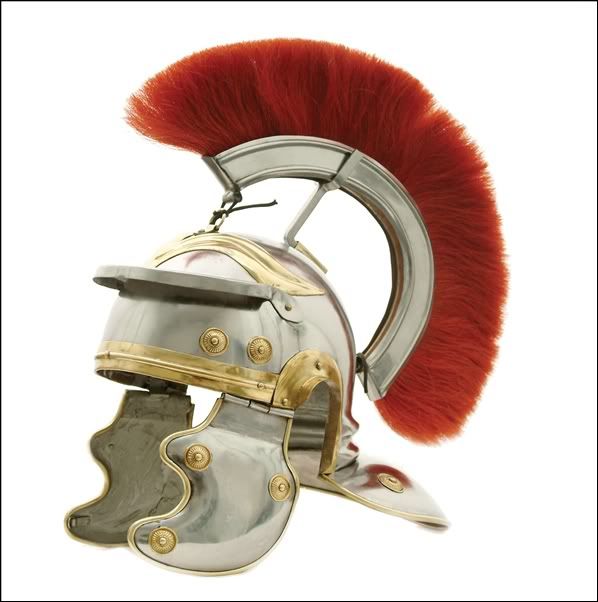 Although it was fought in the East, the Battle of Adrianople had its most direct effect on the affairs of Rome’s western provinces. It initiated a huge influx of Germanic peoples who continued their migrations to overrun the western Roman empire within the next century. In ironic contrast, the eastern Roman empire, with its capital at Constantinople, would survive the fall of Rome itself and, adapting to the eastern environment in which it was isolated amid a sea of barbarians, endure for another 1,000 years.
Although it was fought in the East, the Battle of Adrianople had its most direct effect on the affairs of Rome’s western provinces. It initiated a huge influx of Germanic peoples who continued their migrations to overrun the western Roman empire within the next century. In ironic contrast, the eastern Roman empire, with its capital at Constantinople, would survive the fall of Rome itself and, adapting to the eastern environment in which it was isolated amid a sea of barbarians, endure for another 1,000 years.
For further reading, Cary, N.C.?based contributor Joe Zentner recommends: Adrianople ad 378: The Goths Crush Rome’s Legions, by Simon MacDowall; and Barbarians, by Tim Newark.
Watch the Battle of Adrianople at

Recent Comments
Blogroll
-
-
-
-
-
-
-
-
Ο χρόνος του χρόνου, και του χρόνου(;)Πριν από 8 χρόνια
-
-
Πως ξεκίνησαν όλα μ’ εμέναΠριν από 10 χρόνια
-
Fashion Tips: Memilih Sepatu Kasual Selain SneakerΠριν από 10 χρόνια
-
-
-
Kansas City, Missouri USA.Πριν από 11 χρόνια
-
cash loans with bad creditΠριν από 12 χρόνια
-
Ενας φίλος ...Πριν από 13 χρόνια
-
-
-
untill further noticeΠριν από 16 χρόνια
-
Χρόνια Πολλά και Καλή ΧρονιάΠριν από 16 χρόνια
-
Grey's Anatomy. season 2 - 15Πριν από 17 χρόνια
-
Secret Agent - Hitchcock, 1936Πριν από 17 χρόνια
-
5 - Vietnam War - Dear AmericaΠριν από 17 χρόνια
-
Πεντάγωνο – ΗΠΑ – 11/9/2001Πριν από 17 χρόνια
-
-
-
-
-
-
Blogroll 2
-
-
Call for new bloggersΠριν από 13 χρόνια
-








